Archaeological excavations carried out since 2015 on the site of the Battle of Waterloo (1815) have yielded only very rare human remains... However, these modest discoveries raise a major question:where did the bodies of tens of thousands of men and horses of this Napoleonic battle? One explanation, -not relayed as it is macabre-, is that they could have been transformed into fertilizer for agricultural use... A mystery that should soon be re-examined by new archaeological excavations carried out on the famous site.

Wheat fields of Waterloo (Belgium), plain where the famous battle of the Napoleonic Wars took place in June 1815.
As every year since 2015, -excluding the Covid-19 pandemic period-, the British organization "Waterloo Uncovered" , an organization that works in cooperation with soldiers who are injured or suffer from post-traumatic stress disorder (PTSD), participates in archaeological research in the plain of Waterloo (Belgium), the site of the great Napoleonic battle of 1815. Under the leadership by archaeologist Tony Pollard, director of the Center for Battlefield Archeology at the University of Glasgow (Scotland), around sixty participants have already explored many sectors of the battlefield. In 2019, particularly sifting through the surroundings of the Mont-Saint-Jean farm, one of the epicentres of the fighting, they had thus unearthed ammunition and especially three bones from lower limbs - probably from amputation - excavated near the building that served as a field hospital. One of the excavated bones still bore saw marks... "This poignant discovery immediately transformed the atmosphere of the dig, forging a direct connection between the people who had suffered here in 1815 and the veteran soldiers present “, said Tony Pollard in an interview at theGuardian at the time. .
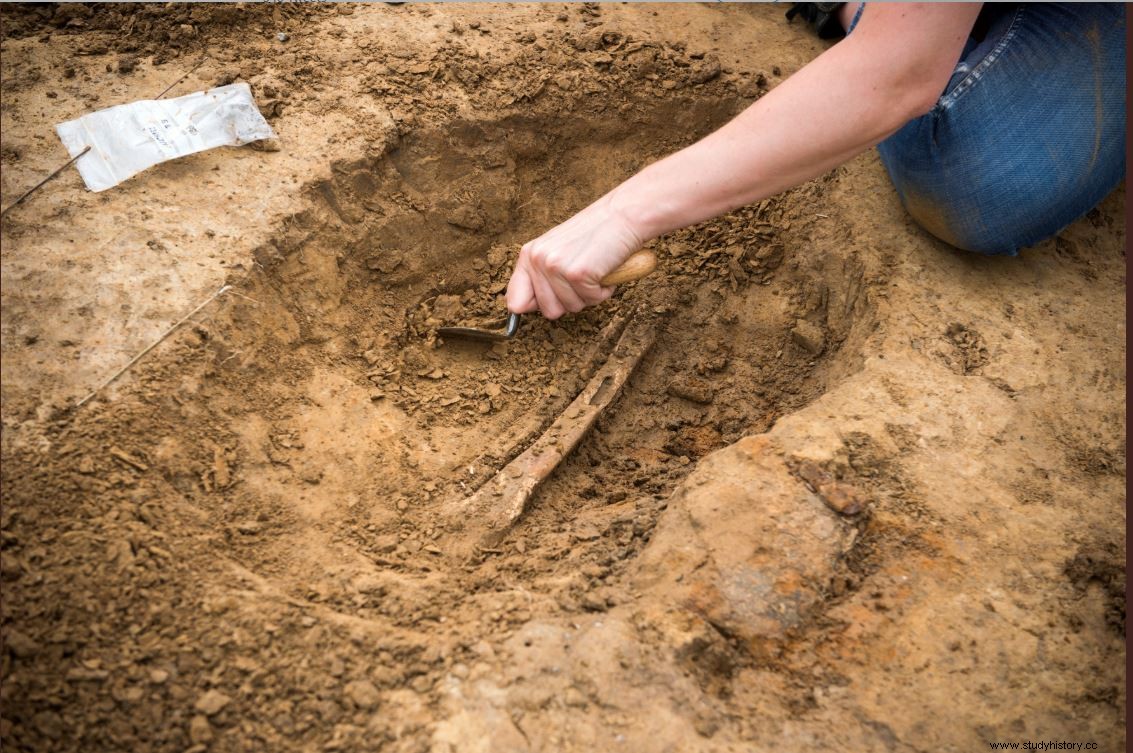
One of the rare human bones unearthed in the plain of Waterloo, during archaeological digs. Credits:Waterloo Uncovered
A puzzling scarcity of human remains
The exhumation of these human remains was above all a first for the Scottish archaeologist who studies the plain of the Battle of Waterloo, "the most terrible carnage I have ever seen ", according to Marshal Ney (1769-1815). The shortage of exhumed bones has indeed long puzzled the specialist:to date, on this site where nearly 269,000 men fought and where approximately 47,000 of them have lost their life or were injured, only one complete skeleton was recovered! em> Legion (KGL) of King George III, Hanoverian military units formed in Great Britain and Ireland between 1803 and 1816. The musket ball that caused his death was even found in the middle of his ribs, the whole being now on display in the site museum.
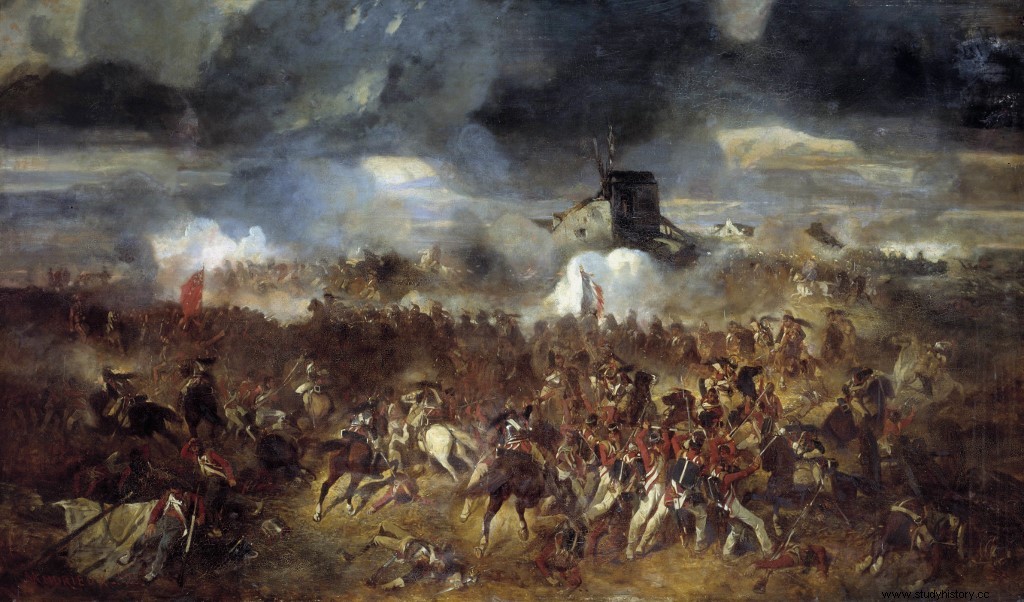
"The Battle of Waterloo, June 18, 1815", by Clément Auguste Andrieux (1829-1880). Credits:AFP
In search of mass graves
So what happened to the remains of the soldiers at Waterloo? Question to which Tony Pollard has just devoted an article in the Journal of Conflict Archeology published on June 18, 2022. The Scottish archaeologist indeed develops a hypothesis:"If it is extremely rare to find human remains on this battlefield, it is because many mass graves have been looted and bones crushed for use as fertilizer in the years following the battle of 1815" . Comments he had already made in an article in the Telegraph July 17, 2019 relayed by the very serious Smithsonian Institute of July 18, 2019 which evoked for its part "the English fertilizer manufacturers who recovered these bones "…! Devil! In the Anglo-Saxon press, things seemed settled! But on this side of the Channel? Are we dealing with a rumour, a piece of folklore to be placed on the long list of urban legends? Or Well, are these proven historical facts? Reading what has been written about the Homeric confrontations that were the Napoleonic battles, it remains difficult today to get an idea of the reality of these profanatory behaviors, so that the cemeteries of the First (1914-1918) and Second World Wars (1939-1945) are the object of all care and commemoration. It should be remembered that the consideration attributed to the individualization of the bodies of soldiers who died in combat is not only happened with the First World War.
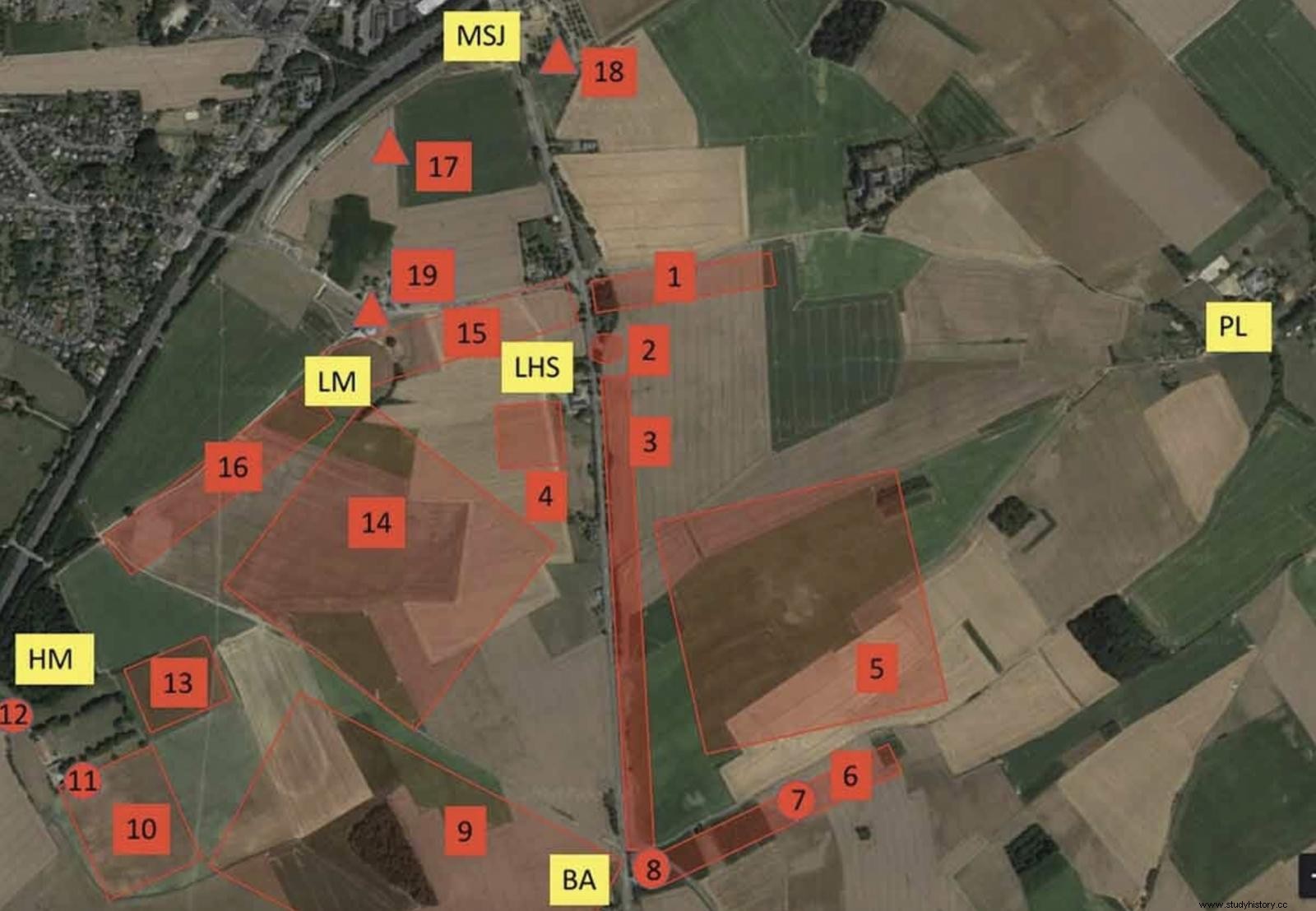
Indicative locations of possible burial sites, concentrations of graves, or pyres, after recent source analysis. Credits:Waterloo Uncovered
In any case, in an attempt to map the location of the pits and burial places not identified to date, the Scottish archaeologist says that he gathered all the existing archival evidence and information from eyewitnesses present the day after the battle. of 1815. Sketches, paintings, stories, pointing out places where pits, large or small, had been dug (see map). In particular recently discovered drawings, and unpublished personal letters and documents from a certain James Ker, a Scottish merchant living in Brussels at the time of the confrontation, whose information collected in Waterloo from June 19, 1815 had never been published. "It would be really interesting to find the location of the pits from which bones were extracted, because any disturbance produces geophysical anomalies in the soils" , explains Tony Pollard. To try to locate them, surveys of the battlefield using electromagnetic methods should start during the next archaeological excavations. When asked, Dr. Kevin Linch, an expert on the Napoleonic Wars at the University of Leeds (who is not involved in this research), said for his part, "there were good reasons to think that the bones of the dead had been taken to be used as fertilizer" . Upcoming works endorsed by the Napoleonic &Revolutionary War Graves Charity , for which it would be important to find and know what really happened to the remains.
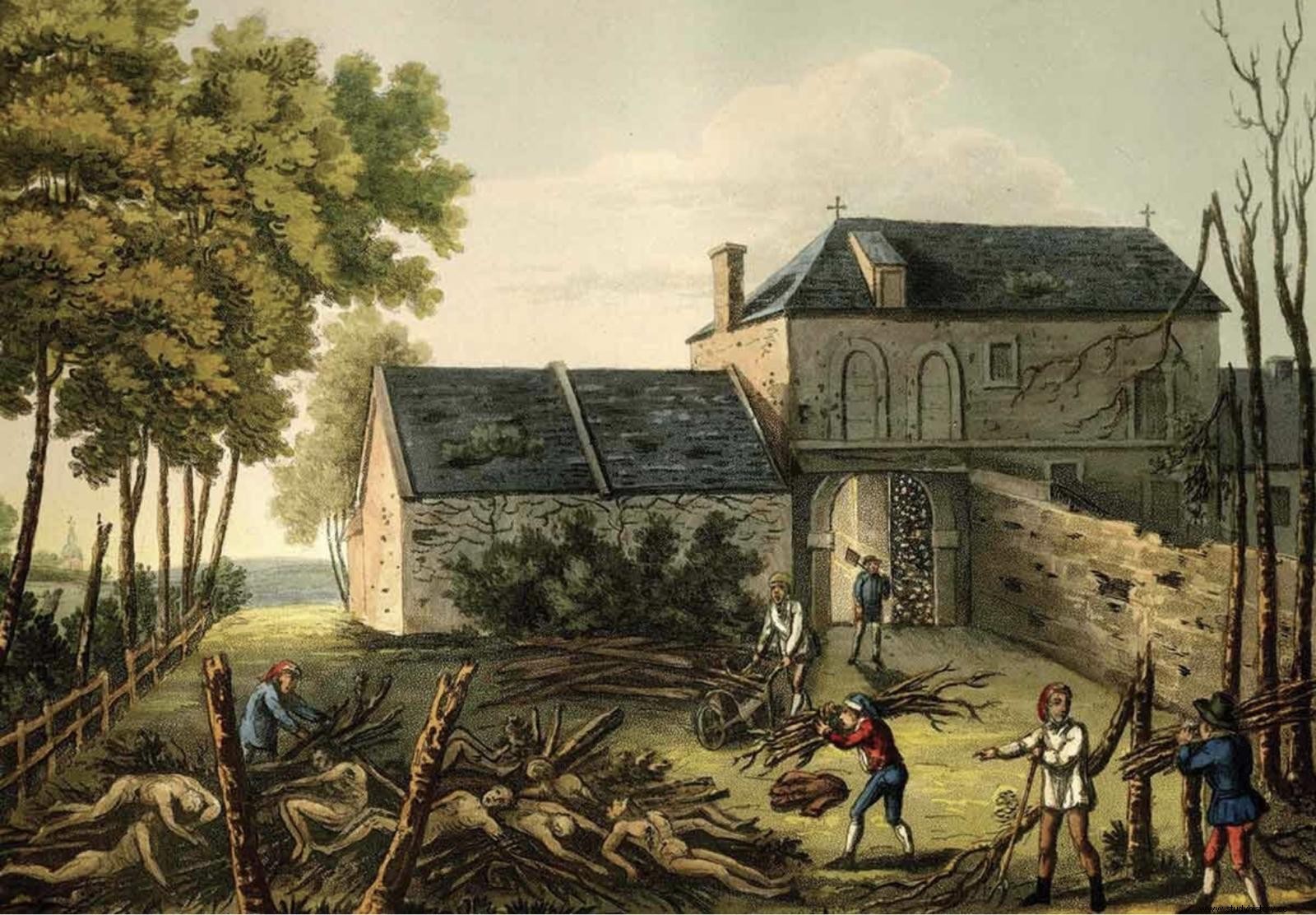
"Burying the dead at the Château d'Hougoumont after the Battle of Waterloo (1815)". Watercolor by James Rouse, from 1817. Credits:Journal of Conflict Archeology
What history tells us is that at Waterloo the dead would have been buried or cremated. The descriptions of the notebooks of Captain Coignet (1799-1815), one of the famous soldiers of the Imperial Guard, make no secret of this since they indicate that "for eight days the stakes burned night and day "; or that "the remains of dead soldiers were piled up in pits" . This was confirmed by a few other discoveries of Napoleonic graves made in the 21st century, like the 3,000 skeletons exhumed in Vilnius (Lithuania) in 2001 (read Sciences et Avenir n° 663) . On the other hand, documents report that as soon as the fighting was over, many were those who went to the battlefields to "rob" the dead, take the soldiers' clothes, their shoes, their weapons - sometimes up to their teeth to make dentures! A collection of artefacts resold as "souvenirs" known to historians.
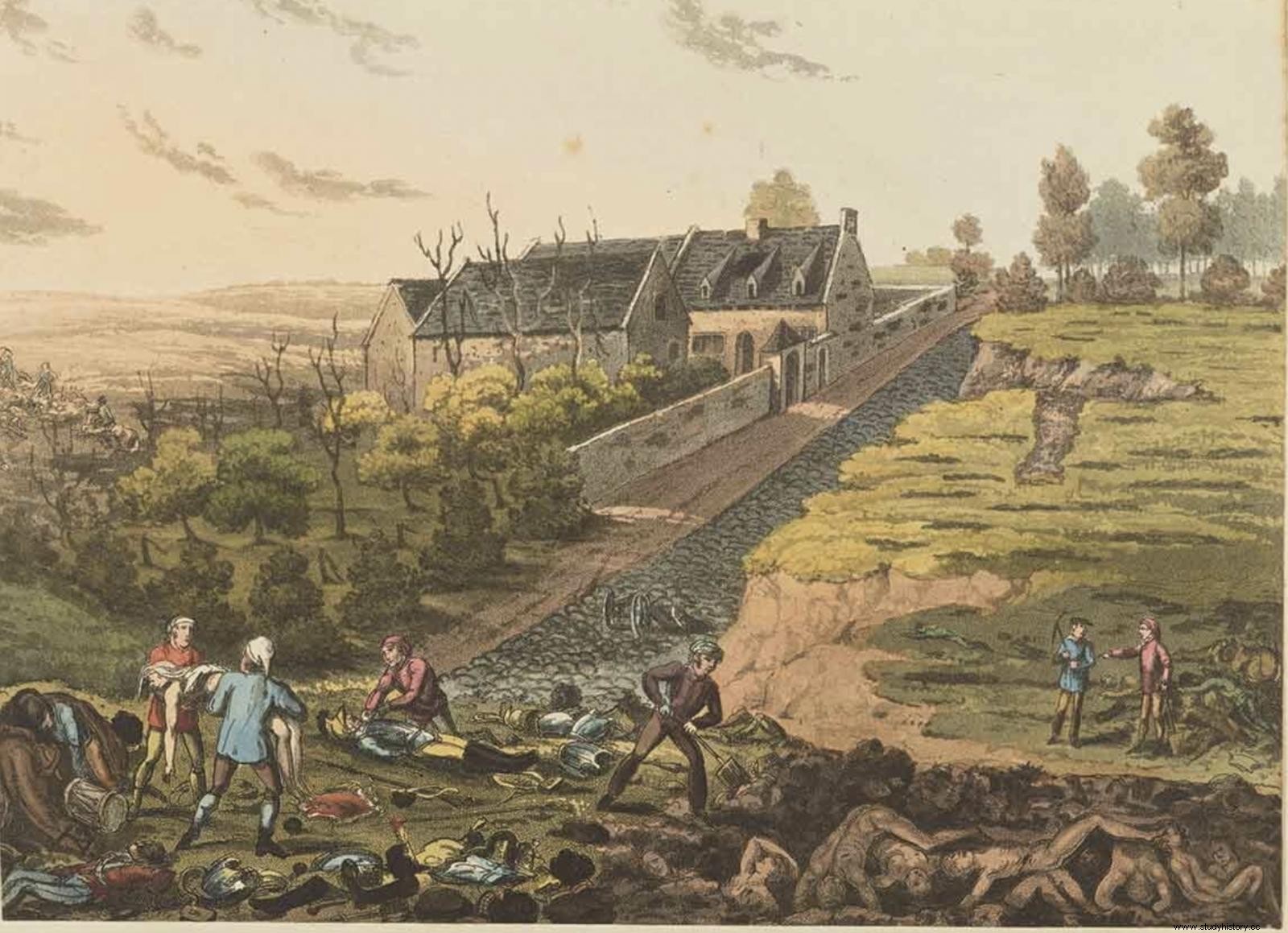
Stripped of their clothes, possessions, weapons and anything of any value, the dead of Waterloo were placed in several mass graves... Credits:Journal of Conflict Archeology
Contacted, specialists in the study of funerary treatments on battlefields recalled that for these Napoleonic periods "the sites were completely cleaned after the battles, and that about fifteen mass graves are documented across Europe, which does not therefore correspond to a total absence of bodies ". Nevertheless, the question posed by archaeologist Tony Pollard is not trivial:did the thousands of men - and tens of thousands of horses - killed on the battlefields of the Napoleonic wars know, - or not? -, this fate, than to have in the 19th century, been transformed into agricultural fertilizer?
This little-mentioned theme seems in fact to be linked to the agricultural development of the time. A subject on which the Scottish archaeologist is working, who told Sciences et Avenir currently writing a book on the subject.
Did fertilizer companies break into the graves of the Napoleonic Wars?
To understand, let's go back to the context of the time. In the 19th century, the German agrochemist Justus von Liebig (1803-1873) highlighted the principle of fertilization. To grow in good conditions, plants must grow in soil rich in nitrogen, potassium and phosphorus. The main idea being that once the crops have been harvested, the nutrients taken must be returned to the earth, otherwise the soil will be depleted. But where to find the precious minerals in quantity? The manure provided by farm animals until then was no longer enough in these dawns of the industrial revolution and the growth of the populations to be fed. To produce more, the crops required the input of massive amounts of fertilizers.
In the years 1830-1840, the bones, very rich in calcium phosphate, would then have been considered excellent fertilizers… Burned or crushed, they were spread in the fields to increase yields. Thus many paleontological fossils ended up pulverized. But they are not the only ones, it seems! English companies would then have thought of the treasure that lay buried under the battlefields... They would have traveled to the sites of the Napoleonic wars to recover the bones of fallen soldiers and horses, then crushed and sold to British farmers.
"Mass graves were emptied by contractors in search of bones used as fertilizer to make bone meal in the first half of the 19th century. There are many newspapers referring to this practice in the era - with major European battlefields in which graves containing large quantities of bones were searched for. Leipzig is another battlefield mentioned in this context. Bones were shipped to ports such as Hull in England, but also to Scotland, where they were crushed to be used as fertilizer to promote the growth of crops Only the mass graves were worth [graves containing numerous bodies, editor's note] and local contacts probably had to be paid to identify the location of these graves. Which isn't to say that every mass grave was treated this way, but many seem to have been “, explained to Sciences et Avenir , archaeologist Tony Pollard, in a previous exchange.
The battlefields of Austerlitz, Waterloo and a few others would thus have been visited. In 1822, a British newspaper reported:"It is estimated that more than a million bushels of human and inhuman bones [horses, editor’s note] were imported from the European continent last year in the port of Hull. The districts of Leipzig, Austerlitz, Waterloo and all the places where the main battles of the last bloody war were fought were alike swept away by the bones of the hero and the horse he rode. Thus collected quarterly, they were shipped to the port of Hull and then taken to the bone-grinders of Yorkshire, who installed steam engines and powerful machinery with the aim of reducing them to granular form. [..They were sent mainly to Doncaster, one of the biggest agricultural markets in this part of the country, and sold to farmers to clear their land…]"
An "ambitious" geophysical campaign
In the Journal of the statistical society of Paris, and its session of March 4, 1863, one could read: "English culture is so imbued with the importance of the role of phosphate of lime as a fertilizer, that speculators searched for it, all the battlefields of Europe, and until recently, ships brought, in the English ports, where they were sold at a high profit, cargoes of human bones collected in the Crimea ".
Eventually, however, all these materials were exhausted. These practices are said to have ceased in the 1860s, after a campaign of rumors against farmers, pointing out that they dumped the bodies of their own children in the fields. It should be noted that these same uses, the transformation into fertilizer, concerned the Egyptian mummies brought back by whole cargoes - a fact largely confirmed by historical documents. From 1841, replacing the bones, these fertilizers would have been sought in the islands with guano - mountains of seabird droppings- shipped to Britain and across Europe from the Chincha Islands off the coast of Peru.
To determine once and for all whether the remains of the Waterloo dead have ended up crushed into "bone meal", Tony Pollard and his "Waterloo Uncovered" teams wish to be able to carry out an "ambitious" geophysical campaign in the coming years to try to identify areas where the ground has been disturbed and where the location of old pits could have been… emptied.
On June 18, 1815, opposed in the plain of Waterloo, 18km south of Brussels, the French forces made up of 74,000 men and 266 guns, the Allied Forces (195,000 men), made up of the Anglo-Dutch-Belgian armies:68,000 men, and Prussians:127,000 men. Started at 11:35 a.m., the battle ended around 9 p.m. with the defeat of the Napoleonic troops. The French losses (killed and wounded) amounted to around 20,000 men, as well as the Allied losses, 20,000 men killed and wounded including 7,000 Prussians).
Dictionary of Napoleon's battles , by Alain Pigeard, Taillandier editions.

Forces present in the plain of Waterloo, June 18, 1815 (in blue, the Napoleonic armies). Credits:Journal of Conflict Archeology
